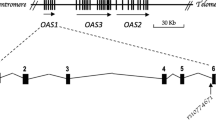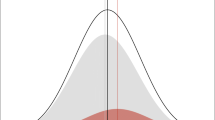Abstract
Osteoarthritis (OA) has a strong genetic component, and experimental evidence suggests the involvement of the Wnt pathway in its pathogenesis. Hence, we explored the association of common single nucleotide polymorphisms (SNPs) related to the Wnt pathway with hip and knee OA. Seventy-eight SNPs were analyzed in 606 patients undergoing joint replacement and in 680 control subjects. SNPs were located in WNT1, WNT10A, WNT16, DVL2, FZD5, BCL9, SFRP1, TCF7L1 and SFRP4 genes. SNPs significantly associated with OA were genotyped in an independent group of 369 patients and 407 controls. One SNP in WNT10A, rs3806557, was associated with hip OA in men (OR 0.65, 95 % CI 0.46–0.93; p = 0.017), but the association was not confirmed in the replication phase. The TCF7L1 polymorphism rs11547160 was also associated with hip OA in the discovery set, but not in the replication set. Similarly, the SFRP4 SNP rs1052981 was associated with knee OA in women with OR of 2.73 (95 % CI 1.29–5.8; p = 0.006), but the association was not replicated. The BCL9 polymorphism rs2353525 was associated with knee OA in women, both in the unadjusted and in the age- and BMI-adjusted analysis (OR 2.01; 95 % CI 1.34–2.98; p = 0.0006). A similar, but not statistically significant, trend was observed in the replication phase. In the combined analysis, OR was 3.13 (1.34–7.28; p = 0.009). These data suggest that some SNPs of genes related to the Wnt pathway and, specifically BCL9, influence the genetic predisposition to osteoarthritis of the large joints in a sex- and joint-specific way.
Similar content being viewed by others
References
Lawrence RC, Helmick CG, Arnett FC, Deyo RA, Felson DT, Giannini EH, Heyse SP, Hirsch R, Hochberg MC, Hunder GG, Liang MH, Pillemer SR, Steen VD, Wolfe F (1998) Estimates of the prevalence of arthritis and selected musculoskeletal disorders in the United States. Arthritis Rheum 41:778–799
Radin EL, Burr DB, Caterson B, Fyhrie D, Brown TD, Boyd RD (1991) Mechanical determinants of osteoarthrosis. Semin Arthritis Rheum 21:12–21
Lories RJ, Luyten FP (2011) The bone-cartilage unit in osteoarthritis. Nat Rev Rheumatol 7:43–49
Gordon MD, Nusse R (2006) Wnt signaling: multiple pathways, multiple receptors, and multiple transcription factors. J Biol Chem 281:22429–22433
Yuasa T, Otani T, Koike T, Iwamoto M, Enomoto-Iwamoto M (2008) Wnt/β-catenin signaling stimulates matrix catabolic genes and activity in articular chondrocytes: its possible role in joint degeneration. Lab Invest 88:264–274
Blom AB, Brockbank SM, van Lent PL, van Beuningen HM, Geurts J, Takahashi N, van der Kraan PM, van de Loo FA, Schreurs BW, Clements K, Newham P, van den Berg WB (2009) Involvement of the Wnt signaling pathway in experimental and human osteoarthritis: prominent role of Wnt-induced signaling protein 1. Arthritis Rheum 60:501–512
Lau KH, Kapur S, Kesavan C, Baylink DJ (2006) Up-regulation of the Wnt, estrogen receptor, insulin-like growth factor-I, and bone morphogenetic protein pathways in C57BL/6J osteoblasts as opposed to C3H/HeJ osteoblasts in part contributes to the differential anabolic response to fluid shear. J Biol Chem 281:9576–9588
Dell’accio F, De Bari C, Eltawil NM, Vanhummelen P, Pitzalis C (2008) Identification of the molecular response of articular cartilage to injury, by microarray screening: Wnt-16 expression and signaling after injury and in osteoarthritis. Arthritis Rheum 58:1410–1421
Dell’accio F, De Bari C, El Tawil NM, Barone F, Mitsiadis TA, O’Dowd J, Pitzalis C (2006) Activation of WNT and BMP signaling in adult human articular cartilage following mechanical injury. Arthritis Res Ther 8:R139
Lories RJ, Peeters J, Bakker A, Tylzanowski P, Derese I, Schrooten J, Thomas JT, Luyten FP (2007) Articular cartilage and biomechanical properties of the long bones in Frzb-knockout mice. Arthritis Rheum 56:4095–4103
Velasco J, Zarrabeitia MT, Prieto JR, Perez-Castrillon JL, Perez-Aguilar MD, Perez-Nunez MI, Sanudo C, Hernandez-Elena J, Calvo I, Ortiz F, Gonzalez-Macias J, Riancho JA (2010) Wnt pathway genes in osteoporosis and osteoarthritis: differential expression and genetic association study. Osteoporos Int 21:109–118
Lindberg H (1986) Prevalence of primary coxarthrosis in siblings of patients with primary coxarthrosis. Clin Orthop Relat Res 203:273–275
Spector TD, MacGregor AJ (2004) Risk factors for osteoarthritis: genetics. Osteoarthritis Cartilage 12(Suppl A):S39–S44
Chitnavis J, Sinsheimer JS, Clipsham K, Loughlin J, Sykes B, Burge PD, Carr AJ (1997) Genetic influences in end-stage osteoarthritis. Sibling risks of hip and knee replacement for idiopathic osteoarthritis. J Bone Joint Surg Br 79:660–664
Riancho JA, Sanudo C, Valero C, Pipaon C, Olmos JM, Mijares V, Fernandez-Luna JL, Zarrabeitia MT (2009) Association of the aromatase gene alleles with BMD: epidemiological and functional evidence. J Bone Miner Res 24:1709–1718
Barrett JC, Fry B, Maller J, Daly MJ (2005) Haploview: analysis and visualization of LD and haplotype maps. Bioinformatics 21:263–265
Conde L, Vaquerizas JM, Dopazo H, Arbiza L, Reumers J, Rousseau F, Schymkowitz J, Dopazo J (2006) PupaSuite: finding functional single nucleotide polymorphisms for large-scale genotyping purposes. Nucleic Acids Res 34:W621–W625
Reumers J, Conde L, Medina I, Maurer-Stroh S, Van Durme J, Dopazo J, Rousseau F, Schymkowitz J (2008) Joint annotation of coding and non-coding single nucleotide polymorphisms and mutations in the SNPeffect and PupaSuite databases. Nucleic Acids Res 36:D825–D829
Purcell S, Neale B, Todd-Brown K, Thomas L, Ferreira MA, Bender D, Maller J, Sklar P, de Bakker PI, Daly MJ, Sham PC (2007) PLINK: a tool set for whole-genome association and population-based linkage analyses. Am J Hum Genet 81:559–575
Cawthorn WP, Bree AJ, Yao Y, Du B, Hemati N, Martinez-Santibanez G, MacDougald OA (2012) Wnt6, Wnt10a and Wnt10b inhibit adipogenesis and stimulate osteoblastogenesis through a β-catenin-dependent mechanism. Bone 50:477–489
Patsopoulos NA, Tatsioni A, Ioannidis JP (2007) Claims of sex differences: an empirical assessment in genetic associations. JAMA 298:880–893
Ikeya M, Takada S (2001) Wnt-3a is required for somite specification along the anteroposterior axis of the mouse embryo and for regulation of cdx-1 expression. Mech Dev 103:27–33
Morice-Picard F, Kostrzewa E, Wolf C, Benlian P, Taieb A, Lacombe D (2011) Evidence of postzygotic mosaicism in a transmitted form of Conradi-Hunermann-Happle syndrome associated with a novel EBP mutation. Arch Dermatol 147:1073–1076
Hirata M, Kugimiya F, Fukai A, Saito T, Yano F, Ikeda T, Mabuchi A, Sapkota BR, Akune T, Nishida N, Yoshimura N, Nakagawa T, Tokunaga K, Nakamura K, Chung UI, Kawaguchi H (2012) C/EBPβ and RUNX2 cooperate to degrade cartilage with MMP-13 as the target and HIF-2α as the inducer in chondrocytes. Hum Mol Genet 21:1111–1123
Xiao SM, Gao Y, Cheung CL, Bow CH, Lau KS, Sham PC, Tan KC, Kung AW (2012) Association of CDX1 binding site of periostin gene with bone mineral density and vertebral fracture risk. Osteoporos Int 23:1877–1887
Sustmann C, Flach H, Ebert H, Eastman Q, Grosschedl R (2008) Cell-type-specific function of BCL9 involves a transcriptional activation domain that synergizes with β-catenin. Mol Cell Biol 28:3526–3537
de la Roche M, Worm J, Bienz M (2008) The function of BCL9 in Wnt/β-catenin signaling and colorectal cancer cells. BMC Cancer 8:199
Mani M, Carrasco DE, Zhang Y, Takada K, Gatt ME, Dutta-Simmons J, Ikeda H, Diaz-Griffero F, Pena-Cruz V, Bertagnolli M, Myeroff LL, Markowitz SD, Anderson KC, Carrasco DR (2009) BCL9 promotes tumor progression by conferring enhanced proliferative, metastatic, and angiogenic properties to cancer cells. Cancer Res 69:7577–7586
Brack AS, Murphy-Seiler F, Hanifi J, Deka J, Eyckerman S, Keller C, Aguet M, Rando TA (2009) BCL9 is an essential component of canonical Wnt signaling that mediates the differentiation of myogenic progenitors during muscle regeneration. Dev Biol 335:93–105
Herrero-Beaumont G, Roman-Blas JA, Castaneda S, Jimenez SA (2009) Primary osteoarthritis no longer primary: three subsets with distinct etiological, clinical, and therapeutic characteristics. Semin Arthritis Rheum 39:71–80
Acknowledgments
Supported by a grant from Instituto de Salud Carlos III (FIS 06/0034). We thank María Torres and Angel Carracedo (Centro Nacional de Genotipado), for genotyping the samples. We also thank Carolina Sañudo, Jana Arozamena and Verónica Mijares for their excellent technical assistance.
Conflict of interest
The authors declare that they do not have conflicts of interest.
Author information
Authors and Affiliations
Corresponding author
Electronic Supplementary Material
Below is the link to the electronic supplementary material.
Rights and permissions
About this article
Cite this article
García-Ibarbia, C., Pérez-Castrillón, J.L., Ortiz, F. et al. Wnt-related genes and large-joint osteoarthritis: association study and replication. Rheumatol Int 33, 2875–2880 (2013). https://doi.org/10.1007/s00296-013-2821-1
Received:
Accepted:
Published:
Issue Date:
DOI: https://doi.org/10.1007/s00296-013-2821-1




